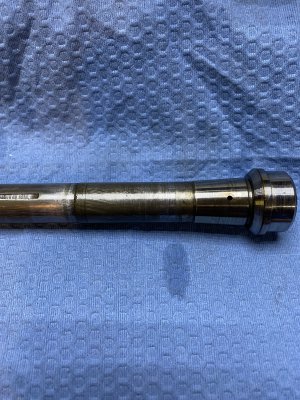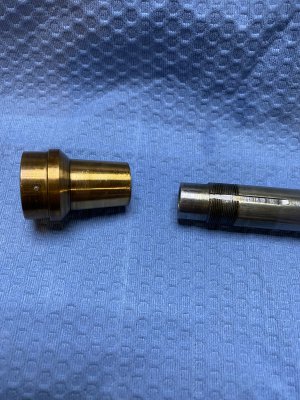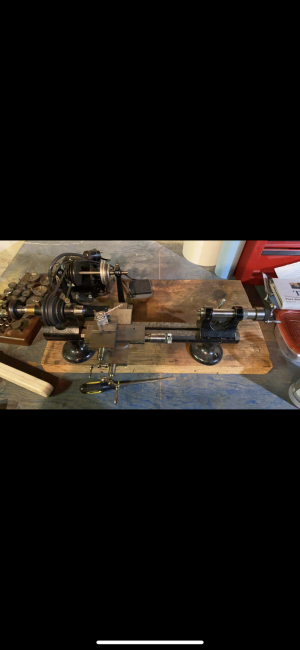-
Welcome back Guest! Did you know you can mentor other members here at H-M? If not, please check out our Relaunch of Hobby Machinist Mentoring Program!
You are using an out of date browser. It may not display this or other websites correctly.
You should upgrade or use an alternative browser.
You should upgrade or use an alternative browser.
Checking a spindle for wear
- Thread starter Brento
- Start date
- Joined
- May 27, 2016
- Messages
- 3,469
Just by coincidence, I have two spindles out right now. This is as part of a little upgrade to my South Bend 9's to replace the fibre washer at the back gear clamp nut with a needle roller thrust bearing. This gives opportunity to closely inspect the spindles.
Of course, getting out the spindles is brand new experience for me, but from what I have picked up on this forum so far, you rarely get outright "wear" without some other damage evidence, like scoring along with overheating. To get this in context, I am talking of spindles that are in journals, possibly bronze bearing journals, or riding directly on the bored-out casting. Spindles are hard, and superfinished, and ride on a film of oil. If this oiling is maintained, then basically, there is no wear, or shall we say, very minimal wear over decades.
Regarding overheating. Of course, if allowed to run without oil for even a short time, bearing surfaces can get to the kind of temperatures that can change colour, but not likely without pickup scoring damage. If the surface is smooth and undamaged, then the colour may just be the evidence of heat treament tempering. On this point, we probably both would welcome some comment from HM members who have real experience of what happened to their spindles. One way wear can happen is because of maladjusted bearing journal. If it is so tight there is clearance less than about 0.0005 all around, the oil film cannot stay in there. If (when stopped), the bearing is loaded down hard, and an indicator set, then hauled up hard (use a pipe or something up the spindle), and look for 0.001" to 0.002", although with the latter, expect greater oil loss. This test is also applied to the rear bearing, and then re-check the front. They affect each other.
When a small metal pick-up occurs, the little lump of metal is torn out and carried around the shaft like a tiny ball, making a scoring ring indent all the way around in the shaft, and also in the journal. If found in time, some score lines on a spindle need not be a disaster. So long as there is still plenty of bearing area, then a fix to the scoring by stoning can work. In this, I do not mean "grinding" with stones. It requires a precision ground flat stone with the tops taken out by a rub on another stone. Stoning like this can be done on a shaft using a certain technique. I contrived my precision flat stones by using a 1/4" thick diamond flat and then rubbing the stones together, as opposed to using a surface grinder.
I hope not seen as getting too far off topic, but if you are going to check out the surface of a spindle using a stone, the best knowledge there is is from Robin Renzetti.
PRECISION GROUND TOOLROOM STONES
Somewhere in there, he shows stoning a round shaft. Do not be afraid of this process. If you do it with full understanding of what is happening, you will not change the dimension of any surface. In my experience, it only provides more of a mirror finish in places. I did this on a scored up counter-shaft. I get it that a countershaft is not the same as a precious spindle, but the principles are the same.
Looking at your pictures, it does not look as if there is major damage anywhere. I will have to try for more of a zoom-up.
Also, I will be taking pictures of my spindles, and doing some measurements.
Of course, getting out the spindles is brand new experience for me, but from what I have picked up on this forum so far, you rarely get outright "wear" without some other damage evidence, like scoring along with overheating. To get this in context, I am talking of spindles that are in journals, possibly bronze bearing journals, or riding directly on the bored-out casting. Spindles are hard, and superfinished, and ride on a film of oil. If this oiling is maintained, then basically, there is no wear, or shall we say, very minimal wear over decades.
Regarding overheating. Of course, if allowed to run without oil for even a short time, bearing surfaces can get to the kind of temperatures that can change colour, but not likely without pickup scoring damage. If the surface is smooth and undamaged, then the colour may just be the evidence of heat treament tempering. On this point, we probably both would welcome some comment from HM members who have real experience of what happened to their spindles. One way wear can happen is because of maladjusted bearing journal. If it is so tight there is clearance less than about 0.0005 all around, the oil film cannot stay in there. If (when stopped), the bearing is loaded down hard, and an indicator set, then hauled up hard (use a pipe or something up the spindle), and look for 0.001" to 0.002", although with the latter, expect greater oil loss. This test is also applied to the rear bearing, and then re-check the front. They affect each other.
When a small metal pick-up occurs, the little lump of metal is torn out and carried around the shaft like a tiny ball, making a scoring ring indent all the way around in the shaft, and also in the journal. If found in time, some score lines on a spindle need not be a disaster. So long as there is still plenty of bearing area, then a fix to the scoring by stoning can work. In this, I do not mean "grinding" with stones. It requires a precision ground flat stone with the tops taken out by a rub on another stone. Stoning like this can be done on a shaft using a certain technique. I contrived my precision flat stones by using a 1/4" thick diamond flat and then rubbing the stones together, as opposed to using a surface grinder.
I hope not seen as getting too far off topic, but if you are going to check out the surface of a spindle using a stone, the best knowledge there is is from Robin Renzetti.
PRECISION GROUND TOOLROOM STONES
Somewhere in there, he shows stoning a round shaft. Do not be afraid of this process. If you do it with full understanding of what is happening, you will not change the dimension of any surface. In my experience, it only provides more of a mirror finish in places. I did this on a scored up counter-shaft. I get it that a countershaft is not the same as a precious spindle, but the principles are the same.
Looking at your pictures, it does not look as if there is major damage anywhere. I will have to try for more of a zoom-up.
Also, I will be taking pictures of my spindles, and doing some measurements.
@graham-xrf thank you. I do agree it does not seem to have alot of wear but i wasnt sure. The brass piece rides in the casting and spins around on a journal so that looks like it has no wear what so ever. The other side of the spindle i do see dark smear marks i guess you could call them so maybe something there but i wasnt sure. I did not wipe the spindle off yet until im ready to clean relubricate and install back into the journals. The journals looked fantastic in the casting i would say.
- Joined
- May 27, 2016
- Messages
- 3,469
I did say I would try for pictures - and I will. I confess I dozed off, I think because my shot of Pfizer's best is beginning to kick in.@graham-xrf thank you. I do agree it does not seem to have alot of wear but i wasnt sure. The brass piece rides in the casting and spins around on a journal so that looks like it has no wear what so ever. The other side of the spindle i do see dark smear marks i guess you could call them so maybe something there but i wasnt sure. I did not wipe the spindle off yet until im ready to clean relubricate and install back into the journals. The journals looked fantastic in the casting i would say.
If you see nice journals without scoring, then it is extremely unlikely there is significant wear. On the matter of oiling, that would be about the most important functionality to be provided, except for the motor actually succeeding in making things rotate! My SB9's use spring loaded capilliary wick system onto the underside of the bearing. I know it was a very successful and low cost method that worked for decades, but I would prefer knowing exactly how much oil makes it through. I plan to ultimately try out one of the better designs of drip feed delivery oilers, but for now, there is much else that has to come first.
What size is your lathe?
- Joined
- May 27, 2016
- Messages
- 3,469
It's cute, and vintage, with a great set of brass collets. This kind of lathe was much valued by horologists.
Given there is no significant scoring on the spindle, you should be able to give it the TLC it deserves. On the matter of felts, I have been experimenting. I am looking at a square-section test piece I cut from about $2 worth of 5mm thick firm felt. I stand one end in some spindle oil, and see it do the capillary thing. I push it down a plastic tube salvaged from a dead gel-pen, and watch the gravity feed drip rate. Of course, one can order the kit, but I chose to play with felts instead.
My South Bend has felts going all over the place, and the ones for the spindle are 3/8 round hard felt rod, spring loaded, and pushing up onto the spindle from underneath, relying on the capillary action to "suck the oil up" to the bearing. I found the tiny hard felt buffing things that come with a Dremel kit do the job just fine. Also, the specials can be cut from a felt buffing wheel, apparently 3 wheels for £4 (I am in the UK)!
In your case, you have the two cap oilers, one over each bearing, and probably a felt along each journal in the casting. Should be fine!
I confess I am much attracted to --> These things
When you re-assemble..
Make very sure there are no burrs in the journals. I am unsure if your journals are fixed hole size, or whether they are adjustable in any way. On my lathe, the journal is split and shims put in the slot, and it gets tightened down with a bolt. The recipe is to fit shims such that when clamped down, it is possible to haul up on the spindle to see about 0.001 deflection on a dial test indicator. This is done for the back bearing also. I don't know if anything like that would apply to your lathe, but for the near zero wear by design, there needs to be an oil film, and a steady, tiny loss of oil out the sides of the journals all the time.
Given there is no significant scoring on the spindle, you should be able to give it the TLC it deserves. On the matter of felts, I have been experimenting. I am looking at a square-section test piece I cut from about $2 worth of 5mm thick firm felt. I stand one end in some spindle oil, and see it do the capillary thing. I push it down a plastic tube salvaged from a dead gel-pen, and watch the gravity feed drip rate. Of course, one can order the kit, but I chose to play with felts instead.
My South Bend has felts going all over the place, and the ones for the spindle are 3/8 round hard felt rod, spring loaded, and pushing up onto the spindle from underneath, relying on the capillary action to "suck the oil up" to the bearing. I found the tiny hard felt buffing things that come with a Dremel kit do the job just fine. Also, the specials can be cut from a felt buffing wheel, apparently 3 wheels for £4 (I am in the UK)!
In your case, you have the two cap oilers, one over each bearing, and probably a felt along each journal in the casting. Should be fine!
I confess I am much attracted to --> These things
When you re-assemble..
Make very sure there are no burrs in the journals. I am unsure if your journals are fixed hole size, or whether they are adjustable in any way. On my lathe, the journal is split and shims put in the slot, and it gets tightened down with a bolt. The recipe is to fit shims such that when clamped down, it is possible to haul up on the spindle to see about 0.001 deflection on a dial test indicator. This is done for the back bearing also. I don't know if anything like that would apply to your lathe, but for the near zero wear by design, there needs to be an oil film, and a steady, tiny loss of oil out the sides of the journals all the time.
The collets are all steel no brass but the felt is little rods. I just ordered them in and will be here on monday. I have a Southbend 9A in the garage but not running at the moment due to no power running to it yet. My plan is to get that going this summer. My plan i think for that lathe is to just check the oilers see how the felt looks and refelt most likely. I know the lathe is in good shape to not tear it apart.




